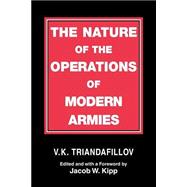
The Nature of the Operations of Modern Armies
by Kipp, Jacob W.; Burhans, William A.; Triandafillov, V. K.Buy New
Rent Textbook
Rent Digital
Used Textbook
We're Sorry
Sold Out
How Marketplace Works:
- This item is offered by an independent seller and not shipped from our warehouse
- Item details like edition and cover design may differ from our description; see seller's comments before ordering.
- Sellers much confirm and ship within two business days; otherwise, the order will be cancelled and refunded.
- Marketplace purchases cannot be returned to eCampus.com. Contact the seller directly for inquiries; if no response within two days, contact customer service.
- Additional shipping costs apply to Marketplace purchases. Review shipping costs at checkout.
Summary
Table of Contents
| The state of modern armies: development of military equipment following the World War - infantry weapons, artillery, chemical weapons, tanks, signal and engineer resources, aviation | |
| possible numerical strength of mobilised armies - small motorised units or million-man armies? mobilisation sequence, possible numerical strength of the mobilisation first echelon in different states, first-line and second-line forces, successive mobilisation echelons, numerical strength of aviation, problems of force quality | |
| established force organisation - correlation between division and corps defensive and offensive resources, modern cavalry, aviation organisation, combat arms correlation, the modern army's transportation resources | |
| Operations of modern armies: premises - density of the operational deployment in the eastern European theatre of military actions, aviation density, division and corps defensive and offensive capabilities, additional suppressive assets for a division and a corps in offensive combat, chemical weapon tactical employment norms | |
| the operation - shock army, approach march to an operational engagement, initiation and conduct of an operational engagement, duration and depth of an operation, attack frontage, forms of the blow, offensive on a wide front, defensive operations, costs of the modern operation | |
| successive operations -premises, how to move large forces laterally in the eastern European theatre of military actions, pace of advancing armies, shock army requirements during prolonged operations, railroad restoration rate, scale of successive operations, nature of shock grouping actions, political support tasks, command and control problems | |
| Table of Contents provided by Publisher. All Rights Reserved. |
An electronic version of this book is available through VitalSource.
This book is viewable on PC, Mac, iPhone, iPad, iPod Touch, and most smartphones.
By purchasing, you will be able to view this book online, as well as download it, for the chosen number of days.
Digital License
You are licensing a digital product for a set duration. Durations are set forth in the product description, with "Lifetime" typically meaning five (5) years of online access and permanent download to a supported device. All licenses are non-transferable.
More details can be found here.
A downloadable version of this book is available through the eCampus Reader or compatible Adobe readers.
Applications are available on iOS, Android, PC, Mac, and Windows Mobile platforms.
Please view the compatibility matrix prior to purchase.
